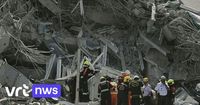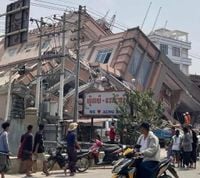A severe earthquake struck Southeast Asia on March 28, 2025, with a magnitude of 7.7 and its epicenter located in central Myanmar. The earthquake, which occurred around 1:00 PM local time, was followed by a significant aftershock measuring 6.4 just ten minutes later, approximately 30 kilometers north of the initial quake. This catastrophic event has left a trail of destruction across the region, particularly affecting Myanmar, where extensive damage has been reported.
In Naypyidaw, the capital of Myanmar, buildings within the military headquarters collapsed, and a traffic control tower at the local airport also fell, tragically resulting in the deaths of all personnel present. Reports indicate that at least twenty individuals perished in a hospital in Naypyidaw, with many more injured as medical staff struggled to cope with the overwhelming number of casualties. Eyewitness accounts describe hospitals treating patients on the streets due to the influx of victims.
The devastation was not limited to Naypyidaw. In Mandalay, Myanmar's second-largest city, which is home to over 1.2 million residents, nearly every building sustained damage. Witnesses reported that a mosque collapsed during Friday prayers, resulting in at least three fatalities. The Mandalay General Hospital confirmed that at least twenty people had died in the city, with over three hundred reported injuries. Additionally, several buildings at the University of Mandalay caught fire, and significant damage occurred at the historic palace, a key tourist attraction.
As the situation unfolded, the military government of Myanmar issued a plea for international aid, highlighting the urgent need for blood donations for victims in Naypyidaw, Mandalay, and Sagaing. The junta's request for assistance marks a significant moment, as it reflects the dire circumstances faced by the nation following the earthquake. Prime Minister Narendra Modi of India quickly offered help, stating, "India stands ready to provide any possible assistance. I have directed the authorities to remain available." Ursula von der Leyen, President of the European Commission, also expressed readiness to support Myanmar and Thailand after the devastating earthquake.
In Thailand, the earthquake's tremors were felt even in Bangkok, located about 1,000 kilometers from the epicenter. The Thai capital was declared a disaster area as a result of the damage caused by the quake. Reports confirmed that a thirty-story building under construction collapsed, claiming at least three lives, and potentially trapping dozens of construction workers beneath the rubble. Rescue operations were launched immediately, with seven individuals successfully pulled from the debris.
Frank Huckriede, a tourist from Hengelo, experienced the earthquake while in his hotel room in Bangkok. He described the moment, saying, "I won’t lie, that was pretty scary. The hotel moved like a Jenga tower. People were running in panic downstairs." Another tourist, Anneke den Hartog, shared her experience of the quake, stating, "We were sitting on a platform by the water when it began to shake. It felt like the movement was coming from the water, and there was panic in the restaurant. Everyone had to go outside." Despite the chaos, the Thai government announced that no state of emergency would be declared in Bangkok, although the situation remained serious.
In Myanmar, the chaos continued as communication lines were disrupted, leaving many without phone or internet connectivity. The government reported significant damage across multiple states, including Naypyidaw, Bago, Magway, Sagaing, and Shan. Eyewitnesses recounted the destruction of roads, bridges, and buildings, with a rescue team member in Mandalay estimating that the death toll could reach several hundred.
As rescue operations unfolded, the local authorities faced challenges due to the lack of resources and infrastructure. Hospitals in Mandalay, Sagaing, and Naypyidaw urgently called for blood donations to assist the growing number of injured. The situation was further complicated by the ongoing conflict in Myanmar, where armed groups have made it increasingly difficult for the military junta to manage crises effectively.
The tremors from the earthquake were felt far beyond Myanmar, with reports of shaking in neighboring countries such as Vietnam, where residents in Hanoi and Ho Chi Minh City also experienced the quake. The Chinese geological service confirmed that the earthquake was felt in Yunnan province, underscoring the widespread impact of this natural disaster.
As the days unfold, the full extent of the damage and loss of life remains unclear, and the international community watches closely. The urgent need for aid and support is palpable, as Myanmar grapples with the aftermath of this devastating earthquake. With the military junta calling for help and foreign nations ready to assist, the coming days will be crucial for the recovery efforts in both Myanmar and Thailand.
In summary, the earthquake on March 28, 2025, has left a significant mark on Southeast Asia, particularly Myanmar, where the loss of life and destruction is profound. As rescue operations continue and aid is mobilized, the resilience of the affected communities will be tested in the face of this disaster.







